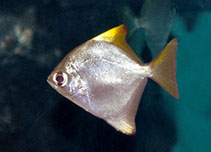| Family: |
Monodactylidae (Moonyfishes or fingerfishes) |
| Max. size: |
27 cm SL (male/unsexed) |
| Environment: |
pelagic-neritic; freshwater; brackish; marine; depth range 0 - 12 m |
| Distribution: |
Indo-West Pacific: Red Sea and east coast of Africa south to the Breë River (Ref. 7293, 52193); also the Persian Gulf (Ref. 96822) to Samoa, north to the Yaeyamas, south to New Caledonia and Australia (Ref. 4959). Known from the freshwater tidal zone of the Mekong delta (Ref. 12693). |
| Diagnosis: |
Dorsal spines (total): 7-8; Dorsal soft rays (total): 27-31; Anal spines: 3-3; Anal soft rays: 27-32. Description: Body diamond-shaped, depth 1.2-1.6 times in standard length (Ref. 52193). Eyes large; mouth small; maxilla width 3.4-5.0 in orbit diameter (Ref. 52193, 90102). Dorsal fin with 8 spines and 27-30 soft rays; anal fin with 3 spines and 27-30 soft rays; pelvic fins small or absent (Ref. 52193). Scales small, 52-58 in lateral line; scales over base of dorsal and anal fins (Ref. 52193). Colouration: Adults bright silver with yellow and dusky dorsal fin tip; small juveniles more colourful with yellow over most of the dorsal fin and two vertical black bands over the head, one through the eye and the second behind the head (Ref. 48636, 52193). Fins yellow except pectoral translucent. (Ref. 90102). |
| Biology: |
Found in bays, mangrove estuaries, tidal creeks, and lower reaches of freshwater streams (Ref. 2847, 44894, 48636); occasionally in silty coastal reefs (Ref. 9710). It feeds on plankton and detritus (Ref. 5213, 44894). Commonly seen in large schools (Ref. 44894, 52193); small juveniles either solitary or in small aggregations (Ref. 48635). Usually only juveniles enter freshwater (Ref. 52193). Highly territorial (Ref. 9710). Caught with throw nets (Ref. 30573). |
| IUCN Red List Status: |
Least Concern (LC); Date assessed: 28 June 2016 Ref. (130435)
|
| Threat to humans: |
harmless |
Source and more info: www.fishbase.org. For personal, classroom, and other internal use only. Not for publication.

